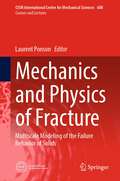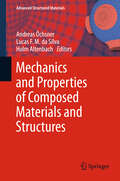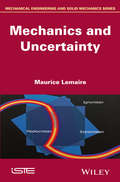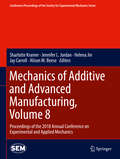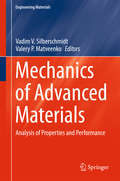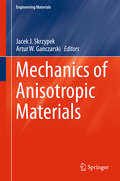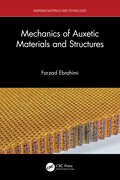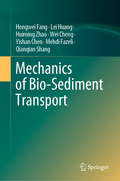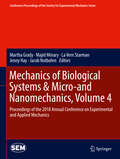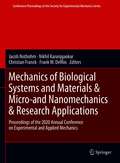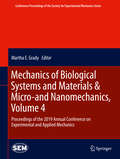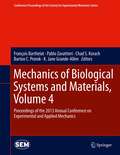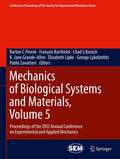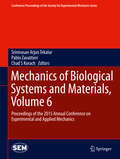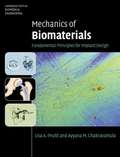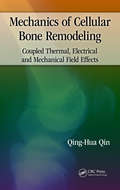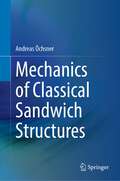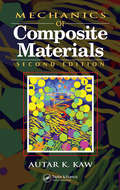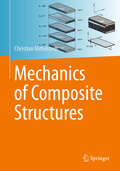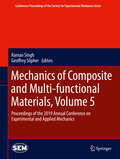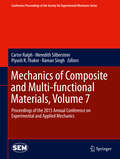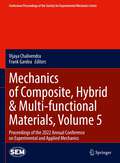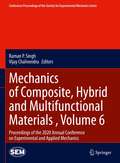- Table View
- List View
Mechanics and Physics of Fracture: Multiscale Modeling of the Failure Behavior of Solids (CISM International Centre for Mechanical Sciences #608)
by Laurent PonsonThe volume provides a comprehensive understanding of the macroscopic failure behavior of solids from the description of the microscopic failure processes and their coupling with the microstructure. Several fundamental questions were addressed: the relation between the microstructural features of materials and their fracture properties and crack trajectories; the role of damage mechanisms and non-linear deformations near the crack tip on the failure behavior of solids; and finally the role of dynamic inertial effects during fast fracture was more briefly evoked. The chapters provide a pedagogical overview of recently developed concepts and tools, that permit to perform the transition from small scales to large ones in fracture problems, thus introducing basic rules for the rational design of tough solids.
Mechanics and Properties of Composed Materials and Structures
by Andreas Öchsner Lucas F. Silva Holm AltenbachThis collection of recent activities provides researchers and scientists with the latest trends in characterization and developments of composed materials and structures. Here, the expression 'composed materials' indicates a wider range than the expression 'composite material' which is many times limited to classical fibre reinforced plastics. The idea of composed structures and materials is to join different components in order to obtain in total better properties than one of the single constituents can provide. In this collection, well known experts present their research on composed materials such as textile composites, sandwich plates, hollow sphere structures, reinforced concrete as well as classical fibre reinforced materials.
Mechanics and Uncertainty
by Maurice LemaireScience is a quest for certainty, but lack of certainty is the driving force behind all of its endeavors. This book, specifically, examines the uncertainty of technological and industrial science. Uncertainty and Mechanics studies the concepts of mechanical design in an uncertain setting and explains engineering techniques for inventing cost-effective products. Though it references practical applications, this is a book about ideas and potential advances in mechanical science.
Mechanics of Additive and Advanced Manufacturing, Volume 8: Proceedings of the 2018 Annual Conference on Experimental and Applied Mechanics (Conference Proceedings of the Society for Experimental Mechanics Series)
by Helena Jin Jay Carroll Alison M. Beese Sharlotte Kramer Jennifer L. JordanMechanics of Additive and Advanced Manufacturing, Volume 8 of the Proceedings of the 2018 SEM Annual Conference & Exposition on Experimental and Applied Mechanics, the eighth volume of eight from the Conference, brings together contributions to this important area of research and engineering. The collection presents early findings and case studies, including: Fatigue & Fracture in AM MaterialsAdditively Manufactured Metals & StructuresAM Process CharacterizationProcessing & Mechanical Behavior of AM MaterialsDynamic Response of AM MaterialsAdditively Manufactured Polymers & Composites
Mechanics of Advanced Materials
by Vadim V. Silberschmidt Valery P. MatveenkoThe book presents interesting examples of recent developments in this area. Among the studied materials are bulk metallic glasses, metamaterials, special composites, piezoelectric smart structures, nonwovens, etc. The last decades have seen a large extension of types of materials employed in various applications. In many cases these materials demonstrate mechanical properties and performance that vary significantly from those of their traditional counterparts. Such uniqueness is sought - or even specially manufactured - to meet increased requirements on modern components and structures related to their specific use. As a result, mechanical behaviors of these materials under different loading and environmental conditions are outside the boundaries of traditional mechanics of materials, presupposing development of new characterization techniques, theoretical descriptions and numerical tools. The book presents interesting examples of recent developments in this area. Among the studied materials are bulk metallic glasses, metamaterials, special composites, piezoelectric smart structures, nonwovens, etc.
Mechanics of Aero-structures
by Sudhakar NairMechanics of Aero-structures is a concise textbook for students of aircraft structures, which covers aircraft loads and maneuvers, torsion and bending of single cell, multi-cell and open thin-walled structures. Static structural stability, energy methods, and aero-elastic instability are discussed. Numerous examples and exercises are included to enhance the students' facility with structural analysis. This textbook is meant for third- and fourth-year undergraduate students in the aerospace and aeronautical engineering programs, and the material included can be covered in a one semester course. A sufficient number of figures are included for the clarity of the subject matter. The book begins with a description of aerodynamic loads to motivate students, and includes an in-depth description of energy methods - an essential topic.
Mechanics of Anisotropic Materials
by Jacek J. Skrzypek Artur W. GanczarskiThe book is focused on constitutive description of mechanical behaviour of engineering materials: both conventional (polycrystalline homogeneous isotropic or anisotropic metallic materials) and non-conventional (heterogeneous multicomponent anisotropic composite materials). Effective material properties at the macro-level depend on both the material microstructure (originally isotropic or anisotropic) as well as dissipative phenomena occurred on fabrication and consecutive loading phase (hardening) resulting in irreversible microstructure changes (acquired anisotropy). The material symmetry is a background and anisotropy is a core around which the book is formed. In this way a revision of classical rules of enhanced constitutive description of materials is required.
Mechanics of Auxetic Materials and Structures (Emerging Materials and Technologies)
by Farzad EbrahimiMechanics of Auxetic Materials and Structures offers a wide range of application-based and practical considerations of smart materials and auxetic materials in engineering structures. Exploring the analytical and numerical solution procedures, the book discusses crucial characteristics of metamaterials and their response to external factors.Covering the effect of different parameters and external factors on the mechanics of auxetic materials and structures, the book considers the benefits leading to better fracture resistance, toughness, shear modulus, and acoustic response.The book serves as a reference for senior undergraduate and graduate students studying civil engineering, mechanical engineering, and materials science and taking courses in smart materials, metamaterials, and mechanics of materials.
Mechanics of Bio-Sediment Transport
by Wei Cheng Hongwei Fang Lei Huang Huiming Zhao Yishan Chen Mehdi Fazeli Qianqian ShangThe main focus of this book is the transport mechanics of sediment particles coated with microbial biofilm, which is called bio-sediment. The book also addresses the question of how to measure and simulate the considerable variation in the properties of natural sediment associated with microbial biofilm, ranging from the micro-scale surface morphology to the macro-scale sediment transport. Nowadays most studies to elucidate the mechanisms of sediment transport have concentrated on physical-chemical sediment properties, little work explicitly coupled sediment dynamics and the environmental effects under the influence of micro-ecosystem, thus leaving a serious gap in water and sediment sciences as well as water ecological research. With respect to physical-chemical sediment properties, this book has been undertaken to evaluate and quantify the effect of biological factors - biofilm on sediment transport mechanics. The chapters cover topics including development of bio-sediment and its properties; model of biofilm growth on sediment substratum; bedform and flow resistance of bio-sediment bed; incipient velocity and settling velocity of bio-sediment; bedload and suspended load transport for bio-sediment; numerical simulation of bio-sediment transport. Besides, the measurement technology, analysis method and expression approach introduced in this book combine the characteristics of hydraulic, environmental and microbial research, having more immediate innovation. This book will be of interest to researchers, managers, practitioners, policy and decision makers, international institutions, governmental and non-governmental organizations, educators, as well as graduate and undergraduate students in the field of hydraulics and river dynamics. It will help to understand the relevance of sediment transport and biofilm growth under the role of aqueous micro-ecosystem, to introduce better tools for the simulation and prediction of bio-sediment transport, and to provide a scientific basis and application foundation for the research of interaction between sediment particles and ecological and environmental factors.
Mechanics of Biological Systems & Micro-and Nanomechanics, Volume 4: Proceedings of the 2018 Annual Conference on Experimental and Applied Mechanics (Conference Proceedings of the Society for Experimental Mechanics Series)
by La Vern Starman Jenny Hay Majid Minary Martha Grady Jacob NotbohmMechanics of Biological Systems & Micro-and Nanomechanics, Volume 4 of the Proceedings of the 2018 SEM Annual Conference & Exposition on Experimental and Applied Mechanics, the fourth volume of eight from the Conference, brings together contributions to important areas of research and engineering. The collection presents early findings and case studies on a wide range of topics, including: Cell Mechanics & Traumatic Brain Injury Micromechanical Testing Adhesion and Fracture MEMS Devices and Technology Nano-scale Deformation Mechanisms 1D & 2D Materials Tribology & Wear Research and Applications in Progress
Mechanics of Biological Systems and Materials & Micro-and Nanomechanics & Research Applications: Proceedings of the 2020 Annual Conference on Experimental and Applied Mechanics (Conference Proceedings of the Society for Experimental Mechanics Series)
by Nikhil Karanjgaokar Jacob Notbohm Christian Franck Frank W. DelRioMechanics of Biological Systems & Micro-and Nanomechanics, Volume 5 of the Proceedings of the 2020 SEM Annual Conference & Exposition on Experimental and Applied Mechanics, the fifth volume of seven from the Conference, brings together contributions to important areas of research and engineering. The collection presents early findings and case studies on a wide range of topics, including:Cell Mechanics & Traumatic Brain InjuryMicromechanical TestingAdhesion and FractureMEMS Devices and TechnologyNano-scale Deformation Mechanisms1D & 2D MaterialsTribology & WearResearch and Applications in Progress
Mechanics of Biological Systems and Materials & Micro-and Nanomechanics, Volume 4: Proceedings of the 2019 Annual Conference on Experimental and Applied Mechanics (Conference Proceedings of the Society for Experimental Mechanics Series)
by Martha E. GradyMechanics of Biological Systems and Materials & Micro-and Nanomechanics, Volume 4 of the Proceedings of the 2019 SEM Annual Conference & Exposition on Experimental and Applied Mechanics, the fourth volume of six from the Conference, brings together contributions to important areas of research and engineering. The collection presents early findings and case studies on a wide range of topics, including: Extreme NanomechanicsIn-Situ NanomechanicsExpanding Boundaries in MetrologyMicro and Nanoscale DeformationMEMS for Actuation, Sensing and Characterization1D & 2D MaterialsCardiac MechanicsCell Mechanics Biofilms and Microbe MechanicsTraumatic Brain InjuryOrthopedic BiomechanicsLigaments and Soft Materials
Mechanics of Biological Systems and Materials, Volume 4: Proceedings of the 2013 Annual Conference on Experimental and Applied Mechanics
by Pablo Zavattieri François Barthelat Barton C. Prorok Chad S. Korach K. Jane Grande-AllenMechanics of Biological Systems and Materials, Volume 4: Proceedings of the 2013 Annual Conference on Experimental and Applied Mechanics, the fourth volume of eight from the Conference, brings together contributions to this important area of research and engineering. The collection presents early findings and case studies on a wide range of areas, including: Structure-Function & Design of Soft Biological Tissues Soft Tissue Biomechanics: Nanoscale to Physiological Control Bone Mechanics Biomimetic Materials Residual Stresses in Biological Materials Cells Cellulose Materials
Mechanics of Biological Systems and Materials, Volume 5
by Pablo Zavattieri George Lykofatitits Elizabeth Lipke François Barthelat Barton C. Prorok Chad S. Korach K. Jane Grande-AllenMechanics of Biological Systems and Materials, Volume 5: Proceedings of the 2012 Annual Conference on Experimental and Applied Mechanics represents one of seven volumes of technical papers presented at the Society for Experimental Mechanics SEM 12th International Congress & Exposition on Experimental and Applied Mechanics, held at Costa Mesa, California, June 11-14, 2012. The full set of proceedings also includes volumes on Dynamic Behavior of Materials, Challenges in Mechanics of Time-Dependent Materials and Processes in Conventional and Multifunctional Materials, Imaging Methods for Novel Materials and Challenging Applications, Experimental and Applied Mechanics, MEMS and Nanotechnology and, Composite Materials and Joining Technologies for Composites.
Mechanics of Biological Systems and Materials, Volume 6
by Pablo Zavattieri Chad S. Korach Srinivasan Arjun Tekalur5thInternational Symposium on the Mechanics of Biological Systems and Materials, Volume 6 of the Proceedings of the 2015SEM Annual Conference& Exposition on Experimental and Applied Mechanics, the sixth volume of nine from the Conference, brings together contributions to this important area of research and engineering. The collection presents early findings and case studies on a wide range of areas, including: Soft Tissues Mechanics Bio-Engineering and Biomechanics Natural Materials & Bio-Inspiration Novel Techniques and Experiments in Biomechanics Tissue Engineering Cells Mechanics
Mechanics of Biomaterials
by Ayyana M. Chakravartula Lisa A. PruittTeaching mechanical and structural biomaterials concepts for successful medical implant design, this self-contained text provides a complete grounding for students and newcomers to the field. Split into three sections: Materials, Mechanics and Case Studies, it begins with a review of sterilization, biocompatibility and foreign body response before presenting the fundamental structures of synthetic biomaterials and natural tissues. Mechanical behavior of materials is then discussed in depth, covering elastic deformation, viscoelasticity and time-dependent behavior, multiaxial loading and complex stress states, yielding and failure theories, and fracture mechanics. The final section on clinical aspects of medical devices provides crucial information on FDA regulatory issues and presents case studies in four key clinical areas: orthopedics, cardiovascular devices, dentistry and soft tissue implants. Each chapter ends with a list of topical questions, making this an ideal course textbook for senior undergraduate and graduate students, and also a self-study tool for engineers, scientists and clinicians.
Mechanics of Cellular Bone Remodeling: Coupled Thermal, Electrical, and Mechanical Field Effects
by Qing-Hua QinResearch on bone remodeling has resulted in much new information and has led to improvements in design and biomedical practices. Mechanics of Cellular Bone Remodeling: Coupled Thermal, Electrical, and Mechanical Field Effects presents a unified exploration of recent advances, giving readers a sound understanding of bone remodeling and its mathemati
Mechanics of Classical Sandwich Structures
by Andreas ÖchsnerThis book treats the mechanical behavior of one-dimensional sandwich structures, a typicaloncept in the context of lightweight design. Such structures are composed of different constituent (e.g., layers) in order to achieve overall properties, which are better than for a single component alone. This book covers the basic mechanical load cases, i.e., tension/compression, bending, and shear. Based on this knowledge, different failure modes, i.e., plastic yielding, and global and local instabilities are investigated. In addition, an introduction to classic optimization problems, i.e., the formulation of an objective function (e.g., the weight of a structure) and corresponding restrictions, is included. The consideration here is limited to one- or two-dimensional design spaces, i.e., with a maximum of two design variables. For such simple cases, the minimum of the objective function can often be determined using analytical or graphical methods.
Mechanics of Composite Materials (Mechanical and Aerospace Engineering Series)
by Autar K. KawIn 1997, Dr. Kaw introduced the first edition of Mechanics of Composite Materials, receiving high praise for its comprehensive scope and detailed examples. He also introduced the groundbreaking PROMAL software, a valuable tool for designing and analyzing structures made of composite materials. Updated and expanded to reflect recent advances in the
Mechanics of Composite Structures
by Christian MittelstedtThis book includes a detailed introduction to the mechanics of composite structures, i.e. thin-walled laminated structures as they are frequently used in lightweight construction and design. The book is subdivided into five parts. Starting from the basics of linear elasticity in part I, part II is devoted to the mechanics of composite laminates as relevant for the further course of this book and as employed in industrial practice. Part III deals with the buckling and postbuckling behaviour of unstiffened and stiffened thin-walled laminated structures and presents closed-form analytical and semi-analytical approaches for the stability analysis of such structures. Part IV includes some advanced topics such as free-edge effects and laminated shells before part V concludes with the analysis of laminated beam structures. This book is intended for students at universities, but also for engineers in practice and researchers in engineering science.
Mechanics of Composite Structures
by László P. Kollár George S. SpringerAn increase in the use of composite materials in areas of engineering has led to a greater demand for engineers versed in the design of structures made from such materials. This book offers students and engineers tools for designing practical composite structures. Among the topics of interest to the designer are stress-strain relationships for a wide range of anisotropic materials; bending, buckling, and vibration of plates; bending, torsion, buckling, and vibration of solid as well as thin walled beams; shells; hygrothermal stresses and strains; finite element formulation; and failure criteria. More than 300 illustrations, 50 fully worked problems, and material properties data sets are included. Some knowledge of composites, differential equations, and matrix algebra is helpful but not necessary, as the book is self-contained. Graduate students, researchers, and practitioners will value it for both theory and application.
Mechanics of Composite and Multi-functional Materials, Volume 5: Proceedings of the 2019 Annual Conference on Experimental and Applied Mechanics (Conference Proceedings of the Society for Experimental Mechanics Series)
by Raman Singh Geoffrey SlipherMechanics of Composite, Hybrid, and Multifunctional Materials, Volume 5 of the Proceedings of the 2019 SEM Annual Conference & Exposition on Experimental and Applied Mechanics, the fifth volume of six from the Conference, brings together contributions to this important area of research and engineering. The collection presents early findings and case studies on a wide range of areas, including: Recycled Constituent Composites Damage Detection Advanced Imaging of Composites Multifunctional Materials Composite Interfaces Tunable Composites
Mechanics of Composite and Multi-functional Materials, Volume 7
by Meredith Silberstein Carter Ralph Raman Singh Piyush R. ThakreExperimental Mechanics of Composite, Hybrid, and Multifunctional Materials, Volume 7 of the Proceedings of the 2015SEM Annual Conference& Exposition on Experimental and Applied Mechanics, the seventh volume of nine from the Conference, brings together contributions to this important area of research and engineering. The collection presents early findings and case studies on a wide range of areas, including: Multifunctional Materials Hybrid Materials Novel Composites Nano- and Particle-Reinforced Composites Additive Manufacturing of Composites Digital Imaging of Composites Damage Detection Non-Destructive Evaluation Fatigue and Fracture of Composites Manufacturing and Joining of Composites Advanced Composites Applications
Mechanics of Composite, Hybrid & Multi-functional Materials, Volume 5: Proceedings of the 2022 Annual Conference on Experimental and Applied Mechanics (Conference Proceedings of the Society for Experimental Mechanics Series)
by Vijaya Chalivendra Frank GardeaMechanics of Composite, Hybrid, and Multifunctional Materials, Volume 5 of the Proceedings of the 2022 SEM Annual Conference & Exposition on Experimental and Applied Mechanics, the fifth volume of six from the Conference, brings together contributions to this important area of research and engineering. The collection presents early findings and case studies on a wide range of areas, including:Recycled Constituent CompositesDamage DetectionAdvanced Imaging of CompositesMultifunctional MaterialsComposite InterfacesTunable Composites
Mechanics of Composite, Hybrid and Multifunctional Materials , Volume 6: Proceedings of the 2020 Annual Conference on Experimental and Applied Mechanics (Conference Proceedings of the Society for Experimental Mechanics Series)
by Vijay Chalivendra Raman P. SinghMechanics of Composite, Hybrid, and Multifunctional Materials, Volume 6 of the Proceedings of the 2020 SEM Annual Conference & Exposition on Experimental and Applied Mechanics, the sixth volume of seven from the Conference, brings together contributions to this important area of research and engineering. The collection presents early findings and case studies on a wide range of areas, including: Recycled Constituent CompositesNanocompositesMechanics of CompositesFracture & Fatigue of CompositesMultifunctional MaterialsDamage Detection & Non-destructive EvaluationComposites for Wind Energy & Aerospace ApplicationsComputed Tomography of CompositesManufacturing & Joining of CompositesNovel Developments in Composites
